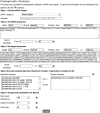sRNATarBase: a comprehensive database of bacterial sRNA targets verified by experiments
- PMID: 20843985
- PMCID: PMC2957045
- DOI: 10.1261/rna.2193110
sRNATarBase: a comprehensive database of bacterial sRNA targets verified by experiments
Abstract
Bacterial sRNAs are an emerging class of small regulatory RNAs, 40-500 nt in length, which play a variety of important roles in many biological processes through binding to their mRNA or protein targets. A comprehensive database of experimentally confirmed sRNA targets would be helpful in understanding sRNA functions systematically and provide support for developing prediction models. Here we report on such a database--sRNATarBase. The database holds 138 sRNA-target interactions and 252 noninteraction entries, which were manually collected from peer-reviewed papers. The detailed information for each entry, such as supporting experimental protocols, BLAST-based phylogenetic analysis of sRNA-mRNA target interaction in closely related bacteria, predicted secondary structures for both sRNAs and their targets, and available binding regions, is provided as accurately as possible. This database also provides hyperlinks to other databases including GenBank, SWISS-PROT, and MPIDB. The database is available from the web page http://ccb.bmi.ac.cn/srnatarbase/.
Figures




Similar articles
-
sRNATarBase 3.0: an updated database for sRNA-target interactions in bacteria.Nucleic Acids Res. 2016 Jan 4;44(D1):D248-53. doi: 10.1093/nar/gkv1127. Epub 2015 Oct 25. Nucleic Acids Res. 2016. PMID: 26503244 Free PMC article.
-
sTarPicker: a method for efficient prediction of bacterial sRNA targets based on a two-step model for hybridization.PLoS One. 2011;6(7):e22705. doi: 10.1371/journal.pone.0022705. Epub 2011 Jul 22. PLoS One. 2011. PMID: 21799937 Free PMC article.
-
PresRAT: a server for identification of bacterial small-RNA sequences and their targets with probable binding region.RNA Biol. 2021 Aug;18(8):1152-1159. doi: 10.1080/15476286.2020.1836455. Epub 2020 Oct 25. RNA Biol. 2021. PMID: 33103602 Free PMC article.
-
Predicting sRNAs and their targets in bacteria.Genomics Proteomics Bioinformatics. 2012 Oct;10(5):276-84. doi: 10.1016/j.gpb.2012.09.004. Epub 2012 Oct 23. Genomics Proteomics Bioinformatics. 2012. PMID: 23200137 Free PMC article. Review.
-
Origin, Evolution, and Loss of Bacterial Small RNAs.Microbiol Spectr. 2018 Apr;6(2):10.1128/microbiolspec.rwr-0004-2017. doi: 10.1128/microbiolspec.RWR-0004-2017. Microbiol Spectr. 2018. PMID: 29623872 Free PMC article. Review.
Cited by
-
Genome-Wide Discovery of Putative sRNAs in Paracoccus denitrificans Expressed under Nitrous Oxide Emitting Conditions.Front Microbiol. 2016 Nov 14;7:1806. doi: 10.3389/fmicb.2016.01806. eCollection 2016. Front Microbiol. 2016. PMID: 27895629 Free PMC article.
-
Accessibility and conservation: general features of bacterial small RNA-mRNA interactions?RNA Biol. 2012 Jul;9(7):954-65. doi: 10.4161/rna.20294. Epub 2012 Jul 1. RNA Biol. 2012. PMID: 22767260 Free PMC article.
-
sRNAdb: a small non-coding RNA database for gram-positive bacteria.BMC Genomics. 2012 Aug 10;13:384. doi: 10.1186/1471-2164-13-384. BMC Genomics. 2012. PMID: 22883983 Free PMC article.
-
Hfq proximity and orientation controls RNA annealing.Nucleic Acids Res. 2012 Sep 1;40(17):8690-7. doi: 10.1093/nar/gks618. Epub 2012 Jul 2. Nucleic Acids Res. 2012. PMID: 22761405 Free PMC article.
-
Sequencing-based analysis of microbiomes.Nat Rev Genet. 2024 Dec;25(12):829-845. doi: 10.1038/s41576-024-00746-6. Epub 2024 Jun 25. Nat Rev Genet. 2024. PMID: 38918544 Review.
References
-
- Backofen R, Hess WR 2010. Computational prediction of sRNAs and their targets in bacteria. RNA Biol 7: 1–10 - PubMed
Publication types
MeSH terms
Substances
LinkOut - more resources
Full Text Sources
Other Literature Sources
Research Materials
